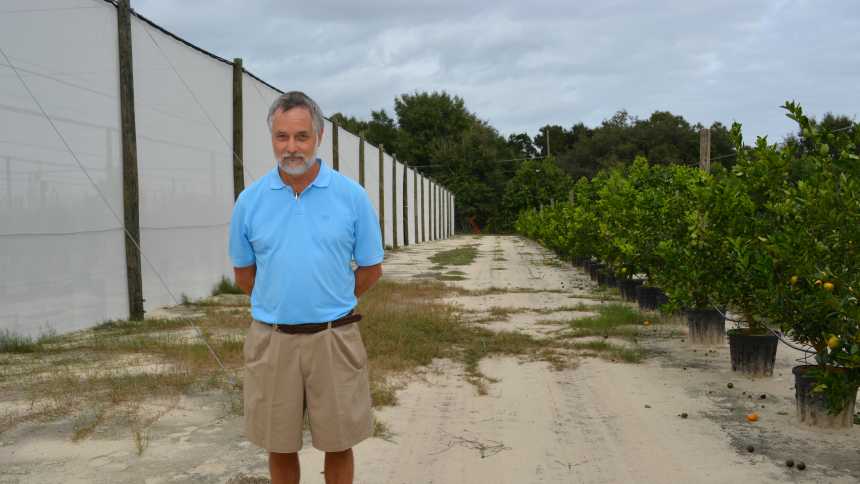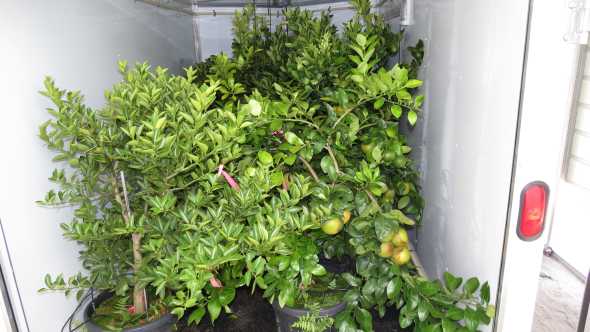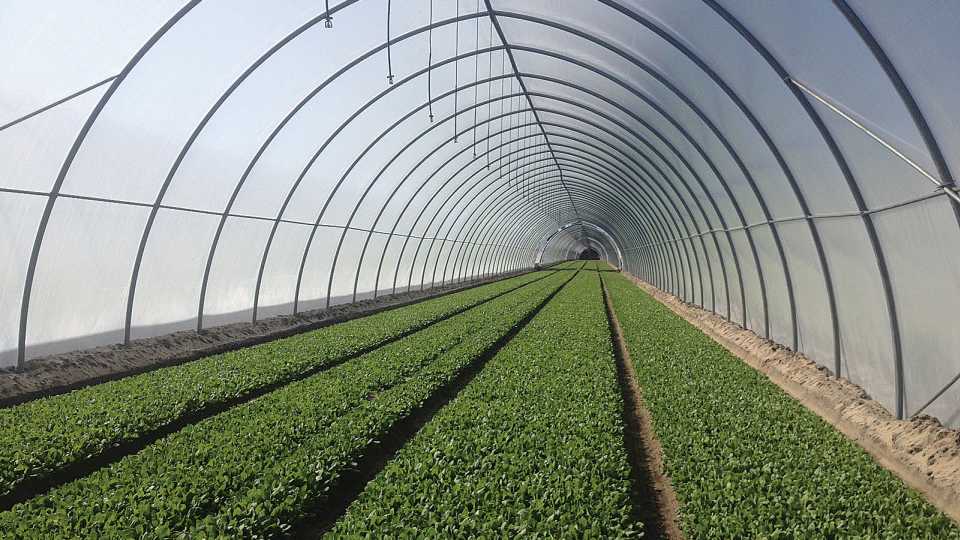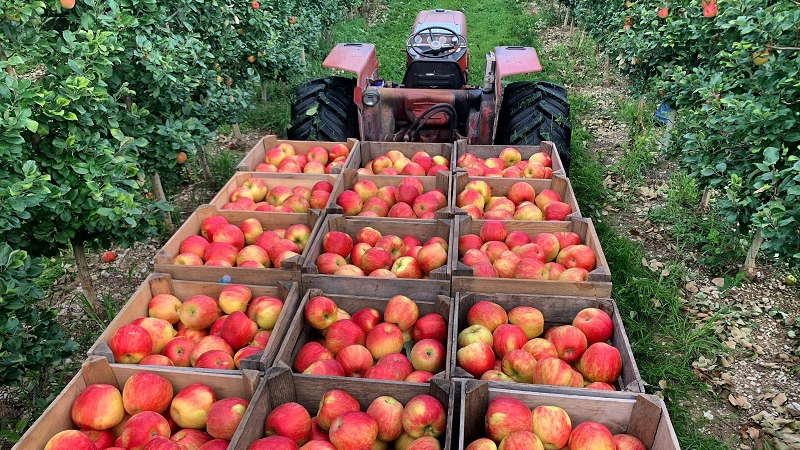Growers, Scientists Seeking Shelter From Citrus Greening

UF/IFAS professor Arnold Schumann is among those leading the charge to test growing citrus under screen structures.
Photo by Frank Giles

Ten years ago, the idea of growing citrus under cover might have been laughable to some, but the arrival of HLB has changed the calculation. Constructing structures that are capable of virtually excluding the psyllid and thereby preventing HLB has a natural attraction in a period when crop forecasts flirt with disaster.
Because of the interest among growers, researchers have put in trials to test production methods under screen structures. And, citrus growers have proven it can be done before. Leading the charge has been Arnold Schumann, a professor of soil and water science and Brian Boman, a professor of agricultural engineering, both with UF/IFAS.
“The crucial, successful conversion of Florida citrus nurseries from open-field production to screenhouse covered production inspired us to try this technology for high-value fresh citrus production in HLB-endemic environments,” Schumann says. “HLB prevention was the main motivation for testing the growing of citrus under cover, and is considered an interim HLB solution.”
There are other possible benefits of covered production that need testing: 1) the possibility of higher yields (greenhouse tomato yields are up to 30 times higher than field-grown); 2) higher-quality fruit and high packout percentage — less wind, therefore less wind scar, protection from hail, sunburn, and other pests, especially leafminer; 3) seedless fruit due to lack of cross-pollination in the absence of insect pollinators; and 4) the prospects of organic citrus production in a protected psyllid-free environment.
Job No. 1
Excluding the psyllid from a citrus planting is the biggest goal of citrus undercover production systems (CUPS). In fall 2014, Schumann constructed a 1.3-acre screenhouse for 1 acre of planted citrus at the Citrus Research and Education Center (CREC) in Lake Alfred. How well has the structure done keeping psyllids out?

Working inside structures, some manual caretaking activities can almost be completely eliminated.
Photo courtesy of UF/IFAS
“Psyllid exclusion has been near perfect,” Schumann says. “After one year, we discovered one psyllid in a sticky trap near the service door of the structure. Very small numbers of psyllids entering the house are tolerated because the trees also are systemically protected via neonicotinoids, and we spray the entire screenhouse on a four-to six-week schedule with broad spectrum insecticides.”
Insecticide applications are made via a 48-inch electric golf cart paired with a conventional airblast sprayer or a twin vertical boom fan sprayer. The golf cart is semi-autonomous and remotely controlled so operators are not exposed to pesticides. An orchard tractor (48-inch cab) also can be used in the system.
While psyllids are excluded by the structure, smaller pests like thrips and mites can penetrate the mesh covering. Going forward, Schumann says he will be focusing more attention on managing thrips and rust mites inside the house.
Analyzing Economics
While psyllid exclusion is important, CUPS has to be profitable to justify the investment. The cost of building the structure and growing trees trellised in high densities in pots with intensive hydroponic management is an expensive proposition. The CREC structure is testing 4×8-foot (1,361 trees per acre) and 5×10-foot (871 trees per acre) densities.

Trees have grown rapidly under the protected structure thanks to high intensity hydroponic management.
Schumann also is testing three different soilless container sizes (5, 7, and 10 gallons). His early observations suggest the 10-gallon size is best for growing under the structure in Florida. Schumann adds it would likely be preferable to grow the trees in the ground on a larger, commercial scale on dwarfing rootstock. In his experiment, the pots themselves limit root development and act to keep tree height in check at 8 to 9 feet.
Next to the screen structure, Schumann has planted a 1 acre trial outside (871 trees per acre) using the same production practices to compare costs, production, and HLB incidence. In addition, these systems are being combined with whole tree thermotherapy treatments (WTT) to manage trees infected by HLB.
“These new production systems must be profitable to be useful,” Schumann says. He adds profitability depends on many factors, including startup costs, annual costs of production, the fruit price, harvestable yield, packout percentage, and the sustainability of yield for many years until the targeted return on investment is reached.
“Our economic projections, led by Dr. Ariel Singerman, an agricultural economist for UF/IFAS, show that the outdoor WTT block could be very profitable under average expected (historic) conditions, but that the covered citrus production option being tested at the CREC would need slightly different combinations of the most important factors determining profitability,” he says. “For example, the price of fresh fruit (Murcott) should be in the $30 per box range, or the cost per acre of the screenhouse should be halved, or the fruit yields per acre should be increased, or various combinations of those factors to achieve profitability.”

Photo courtesy of UF/IFAS CREC
In the CREC trials, mainly commercial varieties are being tested, including grapefruit and Murcott varieties in the larger blocks, but also lemon, lime, navel, Valencia, Hamlin, Satsuma, and new experimental varieties. Schumann says the Murcott varieties likely provide the best potential for returns, as well as some of the premium fresh varieties currently working through the FAST TRACK pipeline.
As far as new varieties, the larger question is: Will they flower under a screenhouse. That remains an unknown until they are tested. C4-15-19, Seedless Snack, 950, RBB 7-34, 7-6-27, and UFGlow are the most logical candidates, but again, testing would need to bear that out.
UFGlow and 7-6-27 have moved on to Tier II of FAST TRACK.
Fruit World in California has proven the practice can produce high yields. The 46-acre hydroponic block (3×7.5 feet = 1,936 trees per acre) produced 1,600 boxes per acre at four years after planting.
“In our trials, we anticipate plateau yields in the 800 to 1,000 boxes per acre range depending on rootstocks, varieties, and hydroponic growing techniques,” Schumann says.
Turning Up The Heat
An integral part of this system being tested at CREC is the ability to treat the entire tree within a steam chamber. The recovery of trees after receiving the thermotherapy has been nothing short of phenomenal.

Photo courtesy of UF/IFAS
Because of solid management, HLB incidence has remained low even in the outdoor experiment. After the first year, only 1.4% of the planting has been infected. Those trees were collected from the planting and moved to the steam chamber, which is housed in a converted covered trailer. By way of comparison, no trees have tested positive for HLB under the screenhouse structure.
Trees are treated in the steam chamber for 48 hours. Desired temperatures range around 108ºF. The air temperature reaches these goals fairly quickly, but it takes the root system in the pots about 15 hours to hit the desired numbers.
So, when should heat treatments be applied in these settings? According to Schumann, as soon as possible. And, he suggests not waiting too late to risk cold injury on newly developed flush or regrowth. That would suggest steam treatments should be made after the last frost and no later than October.










